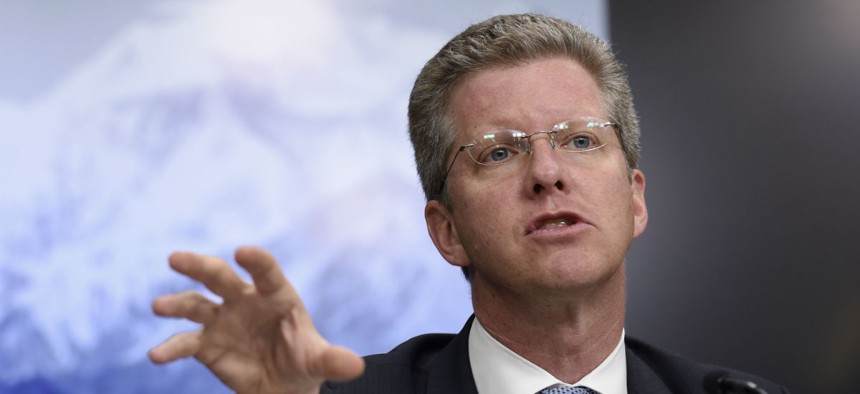Obama Budget Supports a Larger Federal Workforce
Budget Director Shaun Donovan said the blueprint’s 1.6 percent federal pay raise was a tough choice.
President Obama’s $4.1 trillion dollar budget for fiscal 2017—the last of his presidency and one that may be overshadowed by election-year politics—is an “investment in what kind of country we aspire to be,” White House officials said on Tuesday.
“As we make these investments to meet our greatest challenges, we are also working to build a 21st century government that delivers for the American people,” Obama wrote in his annual budget message. “The budget supports efforts to make the federal government more efficient and effective, through smarter information technology delivery and procurement, improving digital services, eliminating outdated regulations, and recruiting and retaining the best talent.”
White House Budget Director Shaun Donovan said the upshot of the 2017 budget is a larger federal workforce. He pointed to plans “for investment in a number of people and skills,” such as $62 million for cybersecurity, and more employees for the Veterans Affairs Department to handle the “wave of veterans coming back from overseas.”
At the Internal Revenue Service, cuts had been so deep that “we got to a place where only 40 percent of taxpayer calls were answered,” Donovan said. New employees were hired last fall “and now [the rate of] the calls answered is up to 60 percent, which is obviously not acceptable.”
Donovan also mentioned proposed investments, under the “people and culture” theme of the president’s management agenda, in federal employee engagement. He noted that in the Federal Employee Viewpoint Survey, for the first time all the questions on engagement recently trended positive.
National Economic Council Director Jeff Zients said, “Innovation is the cornerstone of the president’s budget,” citing proposed investments in manufacturing and clean energy to counter competitors such as China. He also cited the proposed $750 million for National Institutes for Health’s “cancer moon shot.”
Opportunities for common ground with Republicans, Obama’s team agreed, lie not only in cancer research, but cybersecurity, expanding the earned income tax credit, justice reform and efforts to end opioid addiction.
“It’s tempting to adopt the conventional wisdom that a final budget is not relevant,” Donovan said. “But I believe the conventional wisdom is wrong. With last year’s budget, we heard a lot about 'dead on arrival,' but we got 90 percent of investments the president sought, without poison pill riders.”
Ending Sequester Caps
The spending blueprint, which would increase outlays by some 5 percent on such initiatives as cybersecurity, alternative energy and fighting ISIS, would increase the largest account, defense spending, to $582.7 billion. Proposing to curb tax breaks on high-income Americans and raise the tax on oil, it would also eliminate sequester caps in fiscal 2018 and produce a deficit of $503 billion, or 2.6 percent of the gross domestic product (down from 3.3 percent in fiscal 2016).
Its future balance sheets are based on a projected 2.5 percent economic growth rate, which is in line with the Congressional Budget Office and Blue Chip projections, said Council of Economic Advisers Chairman Jason Furman, gauging the overall impact as a tax reduction for most people.
Republicans were quick to pounce on the document and did not relent on their plan announced last week to deny Donovan an appearance before congressional budget committees. “President Obama will leave office having never proposed a budget that balances—ever,” said House Speaker Paul Ryan, R-Wis. “This isn’t even a budget so much as it is a progressive manual for growing the federal government at the expense of hardworking Americans.”
The budget’s proposed 1.6 percent pay raise for troops and federal employees announced last week was a “difficult choice,” Donovan acknowledged. The raise for the second year of last fall’s budget deal “is less than the president wanted,” Donovan said. It “represents progress in paying government workers what they deserve, but it’s not enough,” he added.
Unlike Republican plans to shrink government without tax hikes, the administration takes a “balanced approach,” Donovan said. As much as 50 percent of the $4.5 trillion in deficit reduction achieved since 2009 has been through spending cuts. The new plan includes 117 cuts, consolidations, and savings proposals in such areas as program integrity, which are projected to save over $14 billion in 2017, the budget documents said.
The administration “lived by our words and made tough choices,” Donovan added. “The fight now is within the Republican Party. Do they live by the deal or propose spending below its levels?” he said, referring to recent hints from the House Freedom Caucus that its members may use the fiscal 2017 appropriations process to reopen the two-year budget deal.
“Where do they stand?” Donovan challenged the Republicans. “Do they take us back to manufactured crises and mindless austerity, shutdowns and terrible brinksmanship?”
White House Press Secretary Josh Earnest said Republicans clearly have different priorities, but many goals in the Obama budget are shared by some in the GOP. A similar pessimism was evident when Obama released his budget a year ago, he added, but was followed by accomplishments such as a multi-year highway bill, reauthorization of the No Child Left Behind Act.
When asked why the White House released the budget the same day as the media-saturated New Hampshire primary, Donovan said, “It was hard to find a day free from other distractions.”




